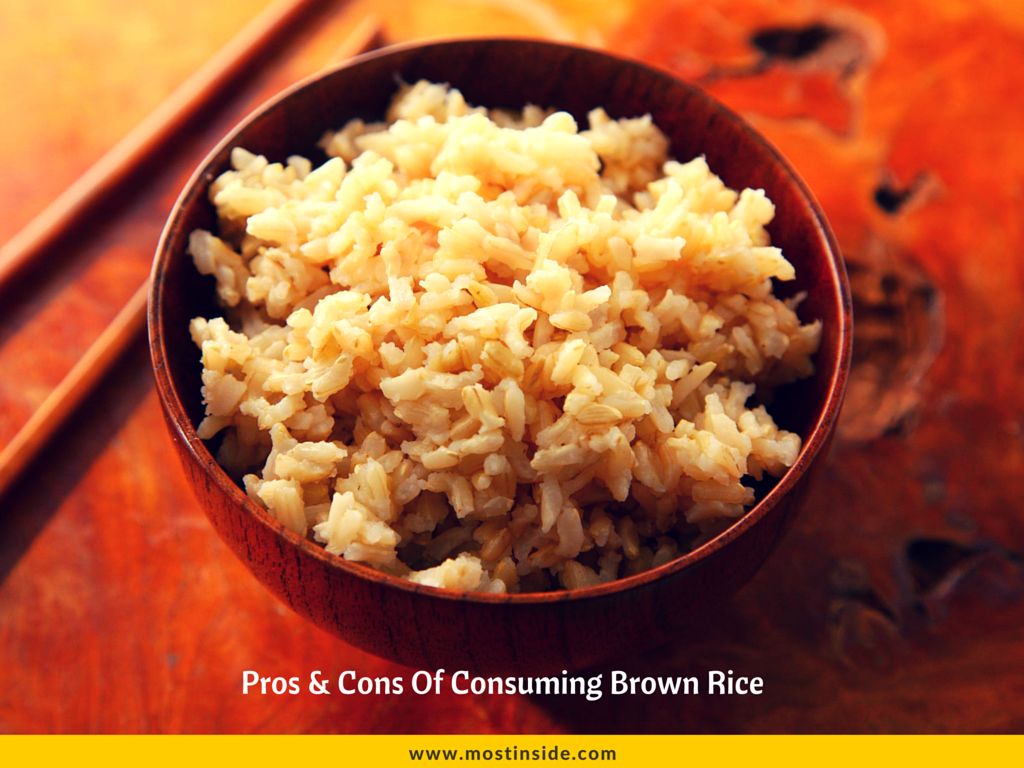Pros & Cons of Consuming Brown Rice
This post was last updated on September 15th, 2023

Over the years, as we are advancing medically, we have come to know that brown rice is highly nutritious in comparison with white rice. Though we basically distinguish both the rice in terms of colour, but it is the manufacturing process that clearly proves why consuming brown rice is more preferred. In order to make brown rice edible, the outer shell or hull is removed, while the white rice is produced by further eliminating the bran and germ layers and then by polishing it.
However, majority of rice consumers prefer buying white rice because it looks more delicious, hence ignoring the health perspective. According to various studies, among people seeking nutritional and other health benefits, brown rice emerged as their first choice. Often people who are seeking to lose weight incorporate brown rice in their diet. Also diabetic patients are advised to have brown rice once a day as it has low glycemic rating, which helps in regulating insulin production.
But lately, it has become a matter of concern if brown rice is truly the best for improving overall health. Though the hull and bran of brown rice offers the wholesome goodness of nutrients like calcium, fibre, magnesium, proteins, potassium, etc., but the process of removing the bran and germ causes exchange of allergy and toxin related dangers.
Amidst all the confusion whether intake of brown rice is healthy or not, presented here are some pros and cons of consuming brown rice that will guide you to purchase the right kind of brown rice:
Contents
TogglePros of Brown Rice
1. Rich In Manganese
Medical studies have stated that consuming one bowl of brown rice can fulfil around 80% of your daily recommended manganese requirements. Besides, it aids in speeding up the fat synthesising process in the body and contributes in regulating the nervous and reproductive systems.
2. High Content of Selenium
Selenium is an essential nutrient that helps in keeping the body immune from critical illnesses like cancer, arthritis and heart diseases too. Brown rice contains high amount of selenium and thereby, you must include brown rice in your diet to protect yourself from becoming prey to such diseases.
3. Contains Abundant Anti-Oxidants
This is one of the least known facts about brown rice. Anti-oxidants are perceived to be available in large amounts in various fruits and vegetables. But the truth is that, even brown rice is a pertinent source of anti-oxidants and daily consumption of one bowl of this rice will keep your health in great state, while augmenting your immunity levels.
4. Rich In Fibre
Brown rice has been adjudged as one of the super foods containing high content of fibre. It helps in preventing colon cancer. These fibre content in brown rice aids in eliminating cancer causing cells as well as toxins from the body. Moreover, people suffering from gastric disorders, digestion issues and irregular bowel movements must incorporate brown rice in their diet.
5. Aids In Weight Loss
Since now you know that brown rice is abundant in fibre that ensures optimum functioning of your digestive system, then it is best for people who are seeking to improve their metabolism rate so that their body doesn’t store food as glucose in the body. Moreover, since small quantity of brown rice consumption can make your tummy feel full, then it is definitely a great dietary food for people intending to lose some extra pounds.
6. Deemed As Whole Grain
The manufacturing process of brown rice itself ensures that it is delivered to end users in purest form and is rich in nutrient quotient. It doesn’t lose its nutritional value despite being subjected to the refinement process. The wholesomeness of this grain helps in preventing cholesterol build up in the arteries and in fact, reduces the risk of suffering from heart disease and high cholesterol.
7. Good For Baby’s Health
Choice of food for babies is generally difficult. But even doctors advise feeding babies with brown rice or brown rice cereal as they have concentrated nutrients and is rich in fibre. Unlike other grains, brown rice doesn’t fall heavy on the baby’s digestive system. Brown rice is considered apt for babies as it speeds up the growth cycles while keeping the baby immune from diseases.
8. Stabilizes Blood Sugar Level
People suffering from diabetes are often suggested to have brown rice instead of white rice. Brown rice has low glycemic index owing to which it helps in stabilizing blood sugar levels. Studies have also found that people who intake a cup of brown rice daily have 60% lesser chance of suffering from diabetes, while people who consume white rice daily have 100 times increased risk of suffering from this disease.
Recommended: 7 Reasons To Limit Caffeine Consumption
Cons of Brown Rice
1. Alpha-Picolinic Acid
Most of us have the habit of storing extra or left-over rice in the refrigerator. But make sure that you consume it within four to seven days as the moisture retained by the rice can pose as a breeding ground for fungi, molds and even bacteria. Moreover, these micro-organisms are capable of converting the amino acid called tryptophan into a compound known as alpha-picolinic acid. If you consume this stale rice, then this compound can possibly cause hypersensitivity and apoptosis, which is a condition that hastens the process of cell death and tissue damage too.
2. Cross Contamination
People suffering from food allergies need to beware before purchasing brown rice. Like all manufactured products, even brown rice may be prone to cross contamination, which may not be suitable for consumption of people sensitive to certain ingredients. Brown rice is a major component for production of variety of products like flours, breads and various snack products.
But the brown rice manufacturers, generally, utilise the same production unit for assortment of foods. Here there is high possibility of brown rice coming in contact with allergenic foods such as gluten, soy and nuts, which can cause severe reactions to people allergic to these food items. So before you purchase brown rice, read the label and get assured that the product is allergy free.
3. Aspergillus Section Flavi
Aspergillus section flavi found in brown rice that has been stored for more than 7 days in the form of molds, bacteria and fungi renders most dangerous impact on health. In fact, medical experts have revealed that this fungus (also known as aflatoxin) can grow on both uncooked and cooked rice and can even cause cancer. Therefore, care must be taken that the rice is properly prepared and cooked and is also consumed as soon as possible to eliminate the risk of becoming a victim of this fungus. However, the risk of getting affected by aflatoxin poisoning is comparatively low, but you must ensure that you purchase best quality brown rice and cook and store it to retain its nutritive values.
4. Arsenic
Apart from getting succumbed to the diseases caused by the molds, fungi and bacteria, brown rice comprises of excessive levels of arsenic which may cause severe health issues if consumed in large quantities. You can however, purchase the organic brown rice to ensure lower levels of arsenic and have limited quantities of them regularly. If you continue to intake brown rice in large portions, then the arsenic can cause organ failure, tissue damage while lowering the life span.
Recommended: Disadvantages of Maida
Recommended For You
Knowing Why and When to Seek Methadone Treatment
Snehashree Bhat
A young writer who loves to pen words from creative perspective. Passionate internet surfer, a versatile homemaker and a person who finds pleasure in adopting healthier and positive changes in her persona. An enthusiastic feminist who wishes to make serious changes in the stereotypical thought process of the society via the voice of her words.




